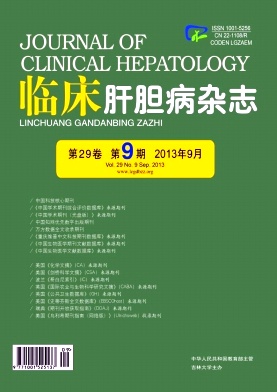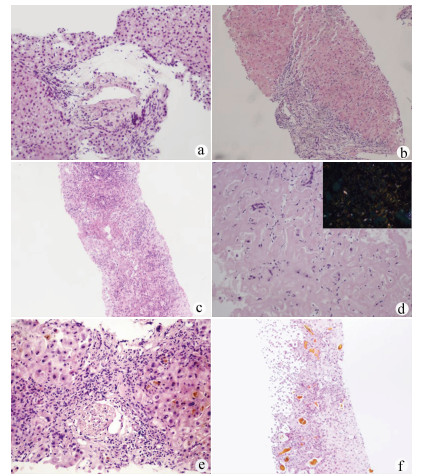|
[1]GILL RQ, STERLING RK.Acute liver failure[J].J Clin Gastroenterol, 2001, 33 (3) :191-198.
|
|
[2]HOOFNAGLE JH, CARITHERS RL Jr, SHAPIRO C, et al.Fulminant hepatic failure:summary of a workshop[J].Hepatology, 1995, 21 (1) :240-252.
|
|
[3]SEABERG EC, BELLE SH, BERINGER KC, et al.Liver transplantation in the United States from 1987-1998:updated results from the Pitt-UNOS Liver Transplant Registry[J].Clin Transpl, 1998:17-37.
|
|
[4]CAPOCACCIA L, ANGELICO M.Fulminant hepatic failure.Clinical features, etiology, epidemiology, and current management[J].Dig Dis Sci, 1991, 36 (6) :775-779.
|
|
[5]FINGEROTE RJ, BAIN VG.Fulminant hepatic failure[J].Am J Gastroenterol, 1993, 88 (7) :1000-1010.
|
|
[6]LEE WM.Acute liver failure[J].Am J Med, 1994, 96 (1A) :3s-9s.
|
|
[7]MUNOZ SJ.Difficult management problems in fulminant hepatic failure[J].Semin Liver Dis, 1993, 13 (4) :395-413.
|
|
[8]SHERLOCK S.Fulminant hepatic failure[J].Adv Intern Med, 1993, 38:245-267.
|
|
[9]SINCLAIR S, WAKEFIELD A, LEVY G.Fulminant hepatitis[J].Springer Semin Immunopathol, 1990, 12 (1) :33-45.
|
|
[10]WIESNER RH.Acute fulminant hepatic failure[J].Transplant Proc, 1991, 23 (3) :1892-1894.
|
|
[11]Randomised trial of steroid therapy in acute liver failure.Report from the European Association for the Study of the Liver (EASL) [J].Gut, 1979, 20 (7) :620-623.
|
|
[12]RAKELA J, MOSLEY JW, EDWARDS VM, et al.A doubleblinded, randomized trial of hydrocortisone in acute hepatic failure.The Acute Hepatic Failure Study Group[J].Dig Dis Sci, 1991, 36 (9) :1223-1228.
|
|
[13]WOOLF GM, REDEKER AG.Treatment of fulminant hepatic failure with insulin and glucagon.A randomized, controlled trial[J].Dig Dis Sci, 1991, 36 (1) :92-96.
|
|
[14]HUGHES R, WWILLIAMS R.Clinical experience with charcoal and resin hemoperfusion[J].Semin Liver Dis, 1986, 6 (2) :164-173.
|
|
[15]O'GRADY J, GIMSON A, O'BRIEN C, et al.Controlled trials of charcoal hemoperfusion and prognostic factors in fulminant hepatic failure[J].Gastroenterology, 1988, 94 (5 Pt 1) :1186.
|
|
[16]ASCHER NL, LAKE JR, EMOND JC, et al.Liver transplantation for fulminant hepatic failure[J].Arch Surg, 1993, 128 (6) :677-682.
|
|
[17]STIEBER AC, IWATSUKI S, STARZL TE.Orthotopic liver transplantation for fulminant and subacute hepatic failure[J].ASAIO Trans, 1988, 34 (4) :959-964.
|
|
[18]TAKAHASHI Y, KUMADA H, SHIMIZU M, et al.A multicenter study on the prognosis of fulminant viral hepatitis:early prediction for liver transplantation[J].Hepatology, 1994, 19 (5) :1065-1071.
|
|
[19]ABECASSIS M, FALK JA, MAKOWKA L, et al.16, 16 Dimethyl prostaglandin E2 prevents the development of fulminant hepatitis and blocks the induction of monocyte/macrophage procoagulant activity after murine hepatitis virus strain 3 infection[J].J Clin Invest, 1987, 80 (3) :881-889.
|
|
[20]ADACHI N, OCHI T, TABO E, et al.Prostaglandin E1 improves hepatic encephalopathy produced by ischaemia-reperfusion liver injury in rats[J].Intensive Care Med, 2000, 26 (11) :1681-1684.
|
|
[21]MONTO GL, SCHEUER PJ, HANSING RL, et al.Attenuation of acetaminophen hepatitis by prostaglandin E2.A histopathological study[J].Dig Dis Sci, 1994, 39 (5) :957-960.
|
|
[22]MUNTANE J, MONTERO JL, MARCHAL T, et al.Effect of PGE1on TNF-alpha status and hepatic D-galactosamine-induced apoptosis in rats[J].J Gastroenterol Hepatol, 1998, 13 (2) :197-207.
|
|
[23]MUNTANE J, RODRIGUEZ FJ, SEGADO O, et al.TNF-alpha dependent production of inducible nitric oxide is involved in PGE (1) protection against acute liver injury[J].Gut, 2000, 47 (4) :553-562.
|
|
[24]QUIROGA J, PRIETO J.Liver cytoprotection by prostaglandins[J].Pharmacol Ther, 1993, 58 (1) :67-91.
|
|
[25]RUWART MJ, RUSH BD, FRIEDLE NM, et al.Protective effects of 16, 16-dimethyl PGE2 on the liver and kidney[J].Prostaglandins, 1981, 21 (Suppl) :97-102.
|
|
[26]SINCLAIR S, LEVY G.Eicosanoids and the liver[J].Ital J Gastroenterol, 1990, 22 (4) :205-213.
|
|
[27]O'BRIEN C, HENZEL B, NAJI A, et al.Prostaglandin E1 infusions improve survival of patients with fulminant hepatic failure[J].Gastroenterology, 1992, 102:a862.
|
|
[28]SINVLSIT SB, GREIG PD, BLENDIS LM, et al.Biochemical and clinical response of fulminant viral hepatitis to administration of prostaglandin E.A preliminary report[J].J Clin Invest 1989, 84 (4) :1063-1069.
|
|
[29]SINCLAIR SB, LEVY GA.Treatment of fulminant viral hepatic failure with prostaglandin E.A preliminary report[J].Dig Dis Sci, 1991, 36 (6) :791-800.
|
|
[30] BERNAUA J, BABANY G, BEZEAUD A.Does prostaglandin E1prevent further aggravation in severe or early fulminant hepatitis?A preliminary open trial[abstract][J].J Hepatol, 1989, 9:s114.
|
|
[31] International conference on harmonisation of technical requirements for registration of pharmaceuticals for human use (ICH) adopts consolidated guideline on good clinical practice in the conduct of clinical trials on medicinal products for human use[J].Int Dig Health Legis, 1997, 48 (2) :231-234.
|
|
[32]HIGGINS JPT, GREEN S.Cochrane handbook for systematic reviews of interventions 4.2.4[updated March 2005].The Cochrane Library, (2) , 2005.
|
|
[33]SHEINER P, SINCLAIR S, GREIG P, et al.A randomized controlled trial of prostaglandin E 2 (PGE 2) in the treatment of fulminant hepatic failure (FHF) [abstract][J].Hepatology, 1992, 16:88-88.
|
|
[34]STERLING RK, LUKETIC VA, SANYAL AJ, et al.Treatment of fulminant hepatic failure with intravenous prostaglandin E1[J].Liver Transpl Surg, 1998, 4 (5) :424-431.
|
|
[35]ZHANG Q, SUN FX.Clinical study on acute, subacute liver failure[J/CD].Chin J Exp Clin Infect Dis (Electronic Edition) , 2012, 6 (2) :165-167. (in Chinese) 张强, 孙凤霞.急性、亚急性肝衰竭临床研究进展[J/CD].中华实验和临床感染病杂志 (电子版) , 2012, 6 (2) :165-167.
|








 下载:
下载:







 DownLoad:
DownLoad: